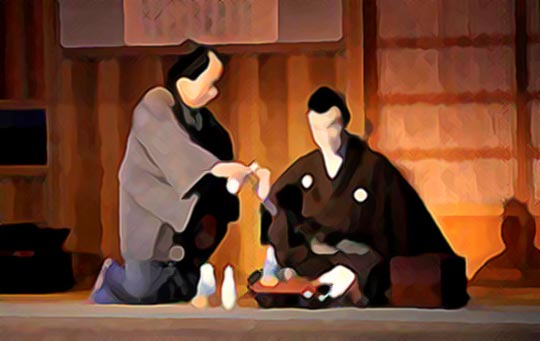| EDO NO Y█BAE |
| Play title | Edo no Yűbae The Sunset of Edo |
|||||||||||||||||||||||||||||
| Author | Osaragi Jir˘ | |||||||||||||||||||||||||||||
| History |
Osaragi Jir˘'s drama "Edo no Yűbae" was premiered in March 1953 at the Kabukiza [casting]. The play is set in the latter stages of the Boshin Wars (Japanese civil war between Imperial and Shogunate forces, 1868-1869) at around the time of the last battle, the Hakodate Sens˘, between the Imperial Forces of the Meiji and the band of samurai warriors remaining loyal to Tokugawa Yoshinobu, the last of the Tokugawa Sh˘guns. |
|||||||||||||||||||||||||||||
| Structure |
"Edo no Yűbae" is made up of 3 acts, divided into 5 scenes: |
|||||||||||||||||||||||||||||
|
||||||||||||||||||||||||||||||
| Key words | Shinkabuki Meiji Ishin Meiji-ishinmono Boshin Sens˘ Hakodate Sens˘ Meiji Yanagibashi |
|||||||||||||||||||||||||||||
| Summary |
Its autumn 1869 and the warships of Viscount Enomoto Takeaki are anchored off Shinagawa preparing to leave for Hakodate. Though the hatamoto D˘mae Daikichi is conflicted between his traditional role as a samurai and the Imperial Government's order reforming the military and the end of the samurai and their social status, he had resisted the urge to side with the Shogunate forces. The headquarters of Daikichi is in the geisha district of Yanagibashi (in today's Tait˘-ku, T˘ky˘) and the upstairs is full of Satsuma samurai, loyal to the Imperial Government, who are drinking with the Tsukuji agent of the geisha Oriki. Downstairs poor boatmen are drinking, unhappy for in a few days' time they'll be shipping out in pursuit of Enomoto's forces to make good the Imperial Government's 1868 declaration dissolving the Shogunate dissolving the Shogunate. Having been held up for sometime by a long rainy spell and, whilst waiting for fine weather, they've been putting the fulfilment of the obligations of their duty on hold. Eventually the person in charge, the powerful, influential and excellent great hatamoto D˘mae Daikichi, makes to move upstairs into the company of the Satsuma country Samurai who, pre-empting Saigo Takamori's actual rebellion of 1877, are talking about their views which differed from Saigo's, who, to the disgrace of the edokko, has resisted the changes in the country with his do-or-die attitude to the bitter end. Daikichi sits on the stairs and listens to their conversation. He makes a speech about the Boshin Wars reaching the peak of its violence, and exhausting the lifeblood of the common people of Edo and absorbing a substantial proportion of the economy. The geisha Oriki, Daikichi's dance teacher, appears and starts to talk about Daikichi's role in and how he was changed by the battle of Toba Fushimi. Daikchi responds with a speech on the futility of war and its effect on the people reflecting the anger of the author of the play, Osaragi Jir˘, at the futility and the destruction caused by the Second World War and the brutal conduct of the Japanese Army (he had attended the T˘ky˘ War Crimes Tribunal). The play briefly turns on a lighter note as, along with some guests,Oriki's shamisen carrier arrives at the boathouse. Daikchi and Oriki chat making light of their situation making reference to their getting fat like sum˘ wrestlers weaving in a reference to the play 'Nuregamiya Inakawa' about a sum˘ wrestler. They talk about a forthcoming festival, Oriki's role as a dance teacher to earn a living and making puns in reference to other plays about sum˘ (skylight - hikimado, where Daikichi is standing, uwate - also a sum˘ belt grip). Hatamoto Honda Koroku is leaving on the ship bound for Hakodate. Matsudaira Kamon's daughter, Otose, Koroku's fiancÚe and Daikichi's cousin, has received a letter of divorce from her former husband opening the way for their marriage. Though Koroku is leaving for Hakodate Otose and her child will stoically await his return. The roles of Ebiz˘ as Koroku and Sh˘roku as Daikichi were specifically written for their style of acting to exhibit Daikichi's feeling that he is still a samurai in spite of his orders and Koroku as single minded in his determination to do what he thinks is right. Oriki's role exhibits a chivalrous spirit. The play succeeds in communicating the edokko spirit of the time as a result of the upheaval that was experienced. Courtesy of Trevor Skingle |
|||||||||||||||||||||||||||||
| Trivia |
This drama was quickly adapted to cinema by the Sh˘chiku Company. The movie "Edo no Yűbae" was directed by Nakamura Noboru (1913~1981) and released in Japan the 1st of September 1954. Most of the male roles were played by the actors starring in the March 1953 Kabuki premiere. The onnagata were (unfortunately?) replaced by actresses; for example the role of the geisha Oriki was played by the great actress Awashima Chikage. |
|||||||||||||||||||||||||||||
 |
|
The hatamoto D˘mae Daikichi (left) and the hatamoto Honda Koroku (right) in a digital painting made by Sh˘riya Araemon in 2011 |
|
|
| Contact | Main | Top | Updates | Actors | Plays | Playwrights | Programs | Links | FAQ | Glossary | Chronology | Illustrations | Prints | Characters | Derivatives | Theaters | Coming soon | News |